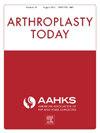The Prediction of Venous Thromboembolism Using Artificial Intelligence and Machine Learning in Lower Extremity Arthroplasty: A Systematic Review
IF 2.1
Q3 ORTHOPEDICS
引用次数: 0
Abstract
Background
Venous thromboembolism (VTE), including deep vein thrombosis and pulmonary embolism, is a common and serious complication following lower extremity arthroplasty, such as total hip and knee arthroplasty. Due to the increasing number of these surgeries, accurately predicting VTE risk is crucial. Traditional clinical prediction models often fall short due to their complexity and limited accuracy.
Methods
This Preferred Reporting Items for Systematic Review and Meta-Analyses–guided systematic review summarized the application of artificial intelligence (AI) and machine learning models in predicting VTE after total joint arthroplasty. Databases including PubMed, Scopus, Web of Science, and Embase were searched for relevant studies published up to January 2024. Eligible studies focused on the predictive accuracy of AI algorithms for VTE post arthroplasty and were assessed for quality using the Newcastle-Ottawa Scale.
Results
A total of 7 retrospective cohort studies, encompassing 579,454 patients, met the inclusion criteria. These studies primarily employed the extreme gradient boosting model, which generally demonstrated strong predictive performance with area under the curve values ranging from 0.71 to 0.982. Models like random forest and support vector machines also performed well. However, only 1 study included external validation, critical for assessing generalizability.
Conclusions
AI and machine learning models, particularly extreme gradient boosting, exhibit significant potential in predicting VTE after lower extremity arthroplasty, outperforming traditional clinical prediction tools. Yet, the need for external validation and high-quality, generalizable datasets remains critical before these models can be widely implemented in clinical practice. The study underscores the role of AI in preoperative planning to enhance patient outcomes in orthopaedic surgery.
应用人工智能和机器学习预测下肢关节置换术中的静脉血栓栓塞:系统综述
静脉血栓栓塞(VTE),包括深静脉血栓形成和肺栓塞,是下肢关节置换术(如全髋关节和膝关节置换术)后常见且严重的并发症。由于此类手术的数量不断增加,准确预测静脉血栓栓塞风险至关重要。传统的临床预测模型由于其复杂性和准确性有限,往往存在不足。方法本系统评价优选报告项目和meta分析引导的系统评价综述了人工智能(AI)和机器学习模型在全关节置换术后静脉血栓栓塞预测中的应用。检索PubMed、Scopus、Web of Science和Embase等数据库,检索截止到2024年1月发表的相关研究。符合条件的研究侧重于人工智能算法对关节置换术后静脉血栓栓塞的预测准确性,并使用纽卡斯尔-渥太华量表评估质量。结果共有7项回顾性队列研究,共纳入579454例患者,符合纳入标准。这些研究主要采用极端梯度增强模型,该模型的曲线下面积在0.71 ~ 0.982之间,总体上具有较强的预测能力。随机森林和支持向量机等模型也表现良好。然而,只有1项研究包括外部验证,这对评估普遍性至关重要。结论ai和机器学习模型,特别是极端梯度增强模型,在预测下肢关节置换术后静脉血栓栓塞方面具有显著的潜力,优于传统的临床预测工具。然而,在这些模型可以广泛应用于临床实践之前,对外部验证和高质量、可推广的数据集的需求仍然至关重要。该研究强调了人工智能在骨科手术术前计划中的作用,以提高患者的预后。
本文章由计算机程序翻译,如有差异,请以英文原文为准。
求助全文
约1分钟内获得全文
求助全文
来源期刊

Arthroplasty Today
Medicine-Surgery
CiteScore
2.90
自引率
0.00%
发文量
258
审稿时长
40 weeks
期刊介绍:
Arthroplasty Today is a companion journal to the Journal of Arthroplasty. The journal Arthroplasty Today brings together the clinical and scientific foundations for joint replacement of the hip and knee in an open-access, online format. Arthroplasty Today solicits manuscripts of the highest quality from all areas of scientific endeavor that relate to joint replacement or the treatment of its complications, including those dealing with patient outcomes, economic and policy issues, prosthetic design, biomechanics, biomaterials, and biologic response to arthroplasty. The journal focuses on case reports. It is the purpose of Arthroplasty Today to present material to practicing orthopaedic surgeons that will keep them abreast of developments in the field, prove useful in the care of patients, and aid in understanding the scientific foundation of this subspecialty area of joint replacement. The international members of the Editorial Board provide a worldwide perspective for the journal''s area of interest. Their participation ensures that each issue of Arthroplasty Today provides the reader with timely, peer-reviewed articles of the highest quality.
 求助内容:
求助内容: 应助结果提醒方式:
应助结果提醒方式:


